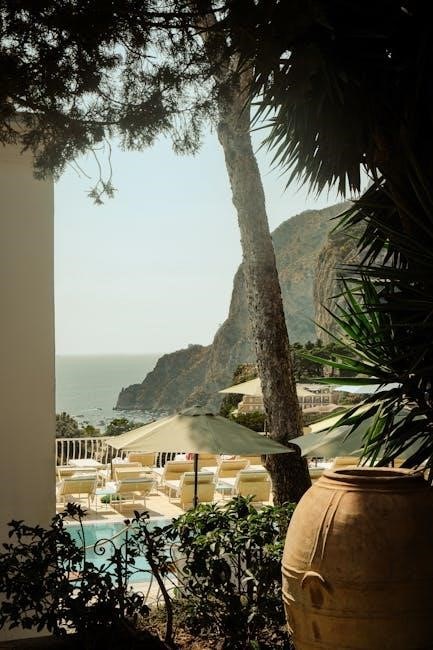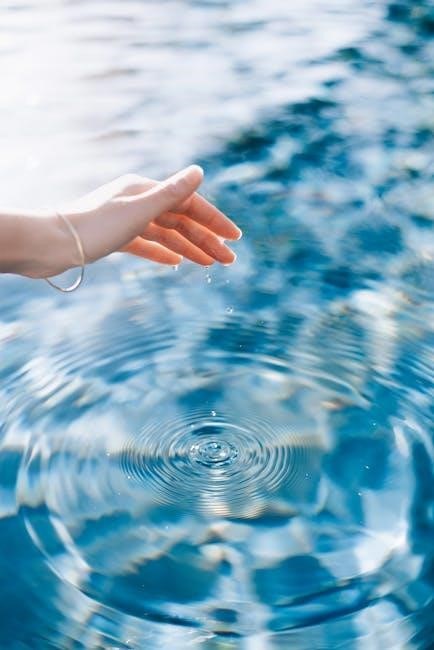Proper pool filter sizing ensures efficient water circulation‚ clarity‚ and system longevity. It involves calculating pool volume‚ flow rates‚ and turnover time to select the ideal filter for your pool.
1.1 Importance of Proper Filter Sizing
Proper pool filter sizing is crucial for maintaining clean‚ safe‚ and energy-efficient water circulation. An undersized filter can lead to poor water quality‚ increased maintenance‚ and premature equipment wear. Conversely‚ an oversized filter may waste energy and increase costs. Correct sizing ensures optimal performance‚ balancing water clarity and system longevity. It also prevents overloading the pump‚ which can damage equipment and hike utility bills. Matching the filter to your pool’s volume‚ usage‚ and pump capacity ensures efficient filtration and extends the lifespan of both the filter and pump. This balance is essential for a healthy‚ enjoyable swimming environment.
1.2 Overview of Pool Filter Types
Pool filters come in three main types: sand‚ cartridge‚ and diatomaceous earth (DE). Sand filters use sand to trap debris and are cost-effective with simple maintenance. Cartridge filters employ a porous cartridge to capture contaminants‚ offering higher efficiency and lower maintenance. DE filters use powdered diatomaceous earth for superior filtration but require more frequent cleaning. Each type has unique benefits and maintenance needs. Sand filters are durable and easy to clean‚ while cartridge filters provide excellent water clarity with replaceable elements. DE filters offer the finest filtration but involve more hands-on upkeep. Understanding these types helps in selecting the best fit for your pool’s needs and your maintenance preferences.

Understanding Pool Volume and Its Impact on Filter Size
Pool volume‚ calculated using dimensions and shape‚ determines the filter size needed for efficient water circulation and clarity. Proper sizing ensures optimal filtration performance and system efficiency.
2.1 Calculating Pool Volume for Rectangular Pools
To calculate the volume of a rectangular pool‚ measure its length‚ width‚ and average depth in feet. Use the formula: Volume = Length × Width × Average Depth × 7.5. For pools with varying depths‚ find the average by adding the shallow and deep ends and dividing by 2. This calculation provides the pool’s volume in gallons‚ which is crucial for determining the minimum flow rate and filter size; Accurate measurements ensure proper filter sizing‚ preventing inefficiency and maintenance issues. Regular calculations help maintain optimal water clarity and system performance. Proper sizing is essential for effective filtration and longevity.
2.2 Calculating Pool Volume for Circular Pools
For circular pools‚ measure the diameter and divide by 2 to find the radius. Use the formula: Volume = π × Radius² × Depth. Multiply the radius by itself‚ then by the depth in feet‚ and finally by 3.142. This gives the volume in cubic feet‚ which is converted to gallons by multiplying by 7.5. Accurate measurements ensure precise volume calculation‚ essential for sizing filters and pumps correctly. Regular recalculations help maintain optimal water clarity and system performance. Proper sizing is vital for efficient filtration and longevity. Always double-check measurements for accuracy.
2.3 Calculating Pool Volume for Irregular-Shaped Pools
For irregular-shaped pools‚ divide the pool into simpler geometric shapes like rectangles and circles. Calculate the volume for each section separately and sum them up; For rectangular sections‚ use the formula: Volume = Length × Width × Depth × 7.5. For circular sections‚ use Volume = π × Radius² × Depth × 7.5. Ensure accurate measurements for each section to avoid errors; This method provides a precise total volume‚ essential for sizing filters and pumps correctly. Always double-check calculations to ensure accuracy. Proper volume calculation is crucial for optimal filtration and system performance.

Determining the Turnover Rate
Determining the turnover rate involves calculating how quickly your pool water cycles through the filter‚ typically every 6 to 8 hours for optimal cleanliness.
3.1 What is Turnover Rate?
The turnover rate refers to the time required for the entire volume of pool water to pass through the filter once. It is crucial for maintaining water clarity and sanitation. A higher turnover rate ensures cleaner water‚ while a lower rate may lead to contamination. Typically‚ pools require a turnover rate of 6 to 8 hours‚ meaning the filter should cycle the entire pool volume within this timeframe. This rate is influenced by pool usage‚ bather load‚ and local regulations‚ making it a key factor in sizing your pool filter correctly for efficient operation and water quality. Proper calculation ensures optimal filtration performance and system efficiency.
3.2 Recommended Turnover Rates for Different Pool Types
Turnover rates vary based on pool type and usage. Residential pools typically require a turnover rate of 6 to 8 hours‚ ensuring clean water for regular use. Commercial pools‚ with higher bather loads‚ may need a faster rate of 4 to 6 hours. Public pools‚ experiencing heavy use‚ often require a turnover rate of 2 to 4 hours to maintain sanitation. Local regulations may dictate specific turnover rates. Properly sizing your filter to meet these rates ensures efficient filtration‚ clean water‚ and adherence to safety standards‚ optimizing your pool’s performance and user experience.
Calculating the Minimum Flow Rate
The minimum flow rate is determined by dividing the pool volume in gallons by the desired turnover rate in minutes for GPM or hours for GPH.
4.1 Formula for Minimum Flow Rate in GPM
To calculate the minimum flow rate in gallons per minute (GPM)‚ use the formula: Minimum Flow Rate (GPM) = Pool Volume (Gallons) / Turnover Rate (Minutes); This formula ensures your filter can handle the required water circulation efficiently. For example‚ if your pool holds 28‚350 gallons and you want a turnover rate of 6 hours (360 minutes)‚ the minimum flow rate would be 28‚350 ÷ 360 = 78.75 GPM. This calculation helps in selecting a filter that can maintain clean and clear water consistently.
4.2 Formula for Minimum Flow Rate in GPH
The minimum flow rate in gallons per hour (GPH) is calculated using the formula: Minimum Flow Rate (GPH) = Pool Volume (Gallons) / Turnover Rate (Hours). This formula helps determine the filter’s required capacity for maintaining water clarity over a specific period. For instance‚ if your pool holds 28‚350 gallons and you aim for a 12-hour turnover rate‚ the calculation would be 28‚350 ÷ 12 = 2‚362.5 GPH. This ensures the filter can process the entire pool volume within the desired timeframe‚ keeping the water clean and safe for swimmers.

Matching Filter Size to Pool Pump Capacity
Matching filter size to pool pump capacity ensures efficient water circulation and prevents system strain. The filter’s flow rate must equal or exceed the pump’s GPM to maintain optimal performance.
5.1 Understanding Pool Pump Horsepower
Pool pump horsepower (HP) determines the pump’s power to circulate water. Higher HP means more water flow‚ measured in gallons per minute (GPM). When sizing your filter‚ ensure its flow rate matches or exceeds the pump’s GPM to avoid pressure issues. Undersizing the filter can lead to system strain‚ while oversizing may waste energy. Always check the pump’s HP and corresponding GPM to select a compatible filter. A balanced system ensures efficient filtration and longevity of both components‚ maintaining clean and clear pool water. Proper alignment is crucial for optimal performance and energy efficiency.
5.2 Sizing the Filter to Match Pump Flow Rate
To ensure efficient operation‚ the pool filter must match the pump’s flow rate. Measure the pump’s GPM (gallons per minute) and select a filter with a compatible flow rate. If the filter’s flow rate is too low‚ it can cause backpressure‚ damaging the pump or plumbing. Conversely‚ a filter with a higher flow rate than needed may be more expensive but won’t necessarily improve performance. Use the pump’s horsepower and GPM to guide your selection‚ ensuring the filter can handle the calculated minimum flow rate based on pool volume and turnover rate. Proper sizing ensures optimal filtration and system longevity.

Pool Filter Size Chart and Recommendations
A pool filter size chart relates pool volume in gallons to recommended filter sizes‚ ensuring optimal filtration. Consider surface area and flow rates for the best fit.
6.1 Optimal Filter Sizes for Different Pool Volumes
For pools up to 10‚000 gallons‚ a 3 sq. ft. sand filter or 100 sq. ft. cartridge filter is ideal. Medium-sized pools (15‚000–25‚000 gallons) require 4.9–5.9 sq. ft. sand filters or 300–400 sq. ft. cartridge filters. Larger pools (30‚000–40‚000 gallons) need 6.9–7.5 sq. ft. sand filters or 500–600 sq. ft. cartridge filters. DE filters typically require 36–48 sq. ft. for pools up to 20‚000 gallons. Always match the filter size to your pool’s volume and pump capacity to ensure efficient flow rates and proper water circulation. Proper sizing prevents pressure issues and extends equipment lifespan. Local regulations may also influence filter size requirements.
6.2 Surface Area Recommendations for Filters
Filter surface area directly impacts water clarity and filtration efficiency. For sand filters‚ a minimum of 3 sq. ft. per 10‚000 gallons is recommended. Cartridge filters require at least 100 sq. ft. for the same volume. DE filters need 36 sq. ft. for pools up to 20‚000 gallons. Larger pools demand proportionally larger filters. Always consider bather load and usage patterns when selecting surface area. Proper sizing ensures optimal flow rates and effective particulate removal. Oversized filters reduce maintenance frequency‚ while undersized ones may struggle to maintain clean water. Balance filter size with pump capacity for a harmonious pool system.
Types of Pool Filters and Their Sizing Considerations
Pool filters come in sand‚ cartridge‚ and DE types‚ each with unique sizing needs. Proper sizing ensures efficiency‚ based on pool volume‚ pump capacity‚ and desired turnover rates.
7.1 Sand Filters
Sand filters are a popular choice for pool filtration‚ offering durability and simplicity. They work by trapping debris as water flows through sand media. Proper sizing is crucial‚ as undersized filters can lead to poor water quality and frequent backwashing. Sand filters are typically sized based on pool volume and pump capacity‚ with recommendations of one square foot of filter area per 10‚000 gallons. They require regular maintenance‚ such as backwashing‚ to ensure optimal performance. Oversizing is generally acceptable but may increase costs. Always match the filter’s capacity with your pool’s specific needs for efficient operation.
7.2 Cartridge Filters
Cartridge filters are a popular choice for pool filtration due to their high efficiency and ease of maintenance. Unlike sand filters‚ they capture finer particles‚ making them ideal for pools with heavy debris. Proper sizing is essential‚ typically based on pool volume and pump flow rate‚ with recommendations of 400 square feet for pools over 25‚000 gallons. While they require less frequent cleaning‚ cartridge replacement is needed every 2-3 years. Oversizing cartridge filters can enhance performance and reduce maintenance frequency‚ providing clearer water and longer equipment lifespan.
7.3 Diatomaceous Earth (DE) Filters
Diatomaceous Earth (DE) filters are known for their exceptional filtration efficiency‚ capturing particles as small as 2 microns. Proper sizing is critical‚ with surface area recommendations based on pool volume and flow rates. For instance‚ a 24 sq. ft. DE filter can handle up to 48 GPM‚ while a 36 sq. ft. model supports 72 GPM. Maintenance involves periodic cleaning of the DE powder coating and replacing the filter grids every 2-3 years. DE filters are ideal for pools requiring high water clarity and are environmentally friendly‚ as they don’t require chemicals to function effectively.

Factors Influencing Filter Size
Pool usage‚ bather load‚ and environmental conditions significantly impact filter size. Higher usage requires larger filters to maintain water quality and clarity efficiently.
8.1 Pool Usage and Bather Load
The size of your pool filter is heavily influenced by how often the pool is used and the number of bathers it serves. High bather loads require larger filters to handle increased contaminants and debris. Commercial pools or residential pools with frequent use need more robust filtration systems. Pool usage patterns‚ such as daily swim sessions or occasional gatherings‚ also play a role. Neglecting these factors can lead to poor water quality or frequent maintenance issues. Always estimate bather load based on maximum expected users to ensure optimal filtration performance and water clarity. Proper sizing ensures efficiency and longevity of your pool system.
8.2 Climate and Environmental Conditions
Climate and environmental factors significantly impact pool filter sizing. In warmer climates with prolonged pool use‚ larger filters may be necessary to handle increased contaminants. High humidity and dust levels can also affect water quality‚ requiring more robust filtration. Areas with heavy foliage may need larger filters to manage debris like leaves. Seasonal changes‚ such as increased algae growth in warmer months‚ further influence filter size. Conversely‚ in colder climates with less frequent use‚ smaller filters might suffice. Environmental conditions like wind and nearby vegetation also play a role in determining the ideal filter size for optimal performance and water clarity year-round.
Maintenance Tips for Extending Filter Lifespan
Regular cleaning‚ backwashing‚ and replacing filter media are essential for extending filter lifespan. Proper maintenance ensures optimal performance and prevents premature wear‚ keeping your pool water clean and clear.
9.1 Cleaning and Backwashing Schedules
Regular cleaning and backwashing are crucial for maintaining filter efficiency. For sand filters‚ backwash every 1-2 weeks or when pressure rises 8-10 PSI. Cartridge filters require cleaning every 1-3 months‚ depending on usage. Diatomaceous Earth (DE) filters need resetting after backwashing‚ ensuring proper re-coating of grids. Consistent maintenance prevents debris buildup‚ optimizes water flow‚ and extends filter lifespan. Always follow manufacturer guidelines for specific cleaning intervals and methods to ensure peak performance and crystal-clear pool water throughout the season.
9.2 Replacing Filter Media
Replacing filter media is essential for maintaining optimal filtration. Sand filters typically require new sand every 5-7 years‚ while cartridge filters need replacement every 1-2 seasons. For DE filters‚ grids should be inspected annually and replaced every 3-5 years. Always use the correct type and amount of media for your filter. Proper replacement ensures clean water‚ prevents system strain‚ and maintains efficiency. Follow manufacturer guidelines for specific replacement intervals and procedures to keep your pool water clear and your filter running smoothly.
Troubleshooting Common Issues
Identify and resolve issues like poor circulation or dirty water by regularly checking filter size and pump compatibility. Ensure optimal performance and water clarity.
10.1 Signs of an Undersized Filter
An undersized pool filter often leads to poor water circulation‚ cloudy or dirty water‚ and increased maintenance needs. You may notice frequent clogging‚ higher pressure readings‚ and shorter filter cycles. Overworked filters can also cause premature wear on the pump and other equipment. Additionally‚ an undersized filter may struggle to handle the pool’s volume‚ leading to inadequate turnover rates and potential health hazards. Regularly monitor for these signs to ensure your pool remains clean and safe. Addressing filter size issues early can prevent costly repairs and extend the lifespan of your pool system.
10.2 Signs of an Oversized Filter
An oversized pool filter may lead to higher initial and operational costs due to increased energy consumption. While it won’t harm the pool‚ it can cause inefficiencies‚ such as unnecessarily high flow rates. Oversized filters may also result in shorter backwashing cycles or frequent cleaning‚ as the system works harder than needed. Additionally‚ pairing an oversized filter with an undersized pump can create pressure imbalances‚ potentially damaging the system. Proper sizing ensures efficiency‚ cost savings‚ and optimal performance. Always match the filter size to your pool’s specific needs to avoid wasting resources and maintain a balanced filtration system.
Additional Considerations
Consider local regulations and future expandability when sizing your pool filter. Ensure compliance with standards and plan for potential upgrades to maintain optimal performance and adaptability over time.
11.1 Local Regulations and Standards
Always check local regulations and standards before finalizing your pool filter size. Many areas have specific requirements for pool filtration systems‚ including minimum turnover rates and equipment standards. For instance‚ NSF Standard 50 provides guidelines for pool filtration systems‚ ensuring safety and efficiency. Compliance with these standards is crucial to avoid legal issues and ensure optimal performance. Additionally‚ some regions may require specific filter types or sizes based on pool usage and environmental conditions. Non-compliance can lead to fines or system inoperation‚ so consulting local authorities or pool professionals is essential to meet all regulatory demands effectively.
11.2 Future Expandability and Upgradability
When sizing your pool filter‚ consider future expandability and upgradability. Anticipate potential upgrades‚ such as adding a spa‚ increasing pool features‚ or enhancing filtration needs. Modular filter systems allow for easy upgrades without replacing the entire unit. Choosing a filter with adjustable flow rates ensures it can adapt to future changes‚ like adding more jets or a heater. Investing in a slightly larger filter now can accommodate future demands‚ saving costs and hassle. A scalable system provides long-term flexibility‚ ensuring your pool remains efficient and functional as needs evolve over time. Plan ahead to avoid costly retrofits later.
Selecting the right pool filter size is crucial for maintaining clean‚ safe‚ and energy-efficient pool water. By understanding pool volume‚ flow rates‚ and turnover times‚ you can ensure optimal filtration. Proper sizing prevents undersized filters from overworking and oversized ones from wasting resources. Regular maintenance and future-proofing your system will extend its lifespan. Whether you choose sand‚ cartridge‚ or DE filters‚ the right size ensures clarity and functionality. Follow these guidelines to make informed decisions and enjoy a pristine pool experience for years to come. Happy swimming!
